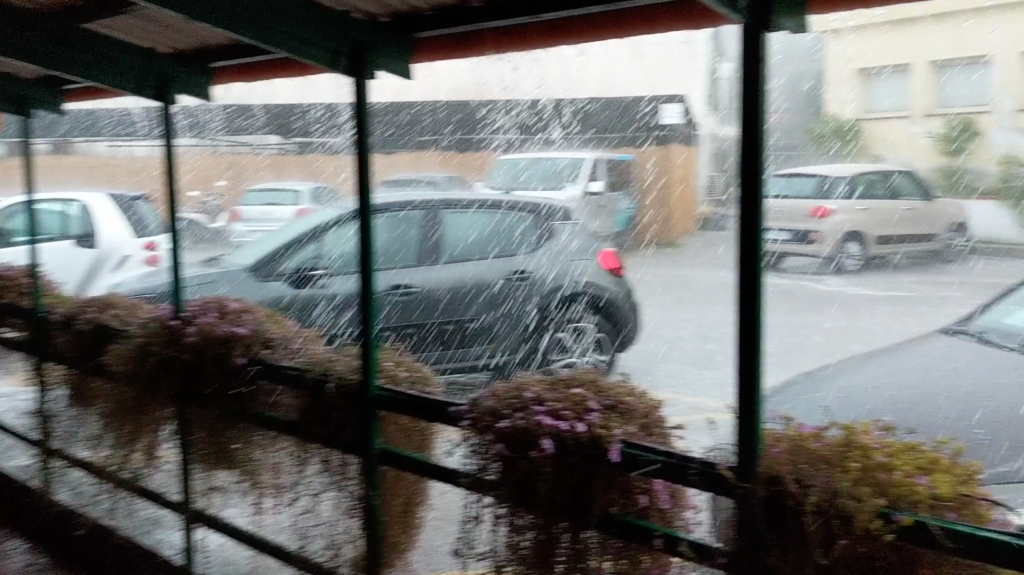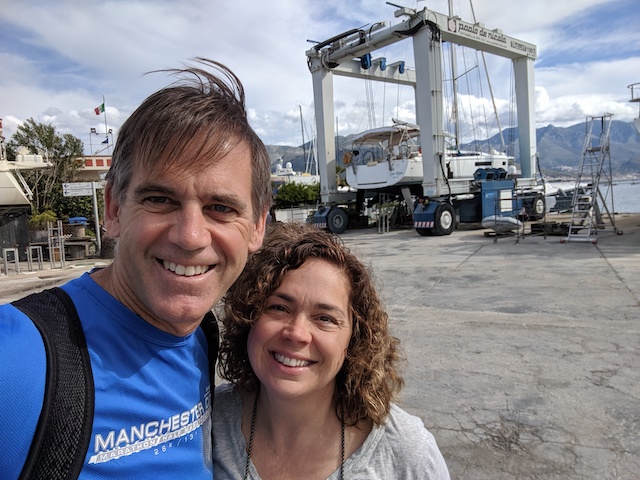For most boaters, springtime does not come quick enough. Like a skier waiting for the first flakes to appear in the Fall, the warm sunny days of Spring herald a new beginning of the boating season. And whether you are in New England or Italy, the feeling is palpable. In years past, stewards as we were of a 20 year old boat, Spring also meant a rush of boat projects, many of which were critical path for launching. Thankfully, with Sea Rose at the young age of 12 months, and having broken her in for 6 of those months on the water last summer, our critical-to-launch list was modest. Our biggest project was the installation of a water maker. These miracles of modern technology take saltwater, even the saltiest of saltwater that settles in the Med, and turns it into beautifully clear, clean drinking water (and showering water, and leave-the-tap-on-while-doing-dishes water, gasp!). We had fitted out Sea Rose quite sufficiently, both from the options we picked through Jeanneau, and our own work efforts last summer. Recently, though, having a water maker was feeling like more of a necessity. If we stayed at marinas every week or so, we could most often fill up our two water tanks and have enough to last for the next week. However, some marinas had questionable water quality, others charged for water; and let’s face it, boaters are an independent lot and don’t like to rely on much from the outside world. So, over the winter I set about researching water makers. For a data scientist guy, this task needed to start with a robust spreadsheet of the many specs and costs. With all the research in hand, we settled on a modest sized unit from Spectra that produces 8 gallons an hour and was light on its energy needs, at just 10 amps. The problem with most water makers, or de-salinators if you want to be exact, is that they take a lot of power. They work by forcing seawater at very high pressure through a fine membrane, which separates the dissolved solids and leaves you with fresh water. It’s more brute force than rocket science. Traditionally, you had to install a generator to get enough power to run the water maker. But we had no interest in another internal combustion energy producer onboard, and opted for the small Spectra model that could run off of our solar array. The Spectra dealer in Florida was more than happy to ship the unit to us in New Hampshire, but happy is not what I would describe Karen’s face when they lowered the unit from the truck bed, shrink-wrapped to a big pallet. “How the he** (could be ‘heck’, mind you!) are we going to get that on the plane”, my newly christened sea captain wife inquired! The optimist and the realist in our household had to huddle and agree on a plan. It just so happened that if you unpacked the pallet and its pieces, you could fit the contents into three large duffle bags that are ever so slightly over the 20kg weight limit for Norwegian Airlines. Phew! There was even room for some of Karen’s clothes, so she wouldn’t have to be forced to skinny dip like those crazy Europeans on summer holiday!

With our bags in tow, and a flirtatious moment with the gate agent, we were airborne to the Med with no overweight baggage fees. Our Norwegian flight took us directly from Boston to Rome, where we rented a car to get us and our water maker to Gaeta, where Sea Rose had hibernated for the winter.
It was fantastic to be back in Gaeta. Here is a town – about halfway between Rome and Naples – that not only has all the necessary services for boaters, but has the charm of an old village center climbing up the hillsides over the harbor, complete with several cathedrals, castle fortifications, and remnants of a Roman bath. Gaeta is roughly split, with half consisting of the historic center, and the other half more modern. And isn’t that what we all could use – a bit of history to remind us where we have come from and to stir our nostalgic juices, while still providing some modern conveniences that we have come to rely upon. Mind you, these modernities still come in the European classic form of cobblestone alleys and tiny merchant stores that require you to shop separately for bread, meat, produce, and sundries. This is not Los Angeles! Karen and I agreed that we could definitely live here. And indeed quite a few Americans do live in Gaeta, serving in the US Navy and its many related local contractor companies. Our Navy sailors manage the amphibious command ship USS Mount Whitney, home ported in Gaeta, which brings with it a considerable American influence, starting each morning with the Star Spangled Banner, and ending with a bit of rowdiness at the bar Rendezvous directly across from the security gates, where yours truly enjoyed on more than one occasion a nice juicy cheeseburger in paradise.


Karen and I stayed at a nearby hotel for a few days as a clean, comfortable retreat from the sweaty, dusty experience at the boatyard getting Sea Rose cleaned and upgraded for launch day. Soon enough, our launch morning arrived. I was over in another part of town returning our rental car when Karen texted me that the travel lift was rolling over to Sea Rose. I sprinted back to the boat yard. The marina, with the mouthful of a name “Base Nautica Flavio Gioia”, hired a very competent crew of hands for this exact operation, and they deftly maneuvered the four wheeled behemoth around other people’s tender crafts and lifted Sea Rose carefully into the air, applying extra bottom paint where the stands had been, and even hoisting our freshly washed and tuned outboard to the stern rail. This was not their first rodeo, which was good, as Karen and I were sweating it as our little baby dropped into the water. I tell people all the time that despite all of the sailing we have done, it is very much an aptitude that fades if you don’t use it regularly. So, every spring it feels like we are re-learning how to maneuver a boat, longing for that familiarity and ease-of-hand that you happily find yourself in at the end of a sailing season. For the record, my mogul-pounding skills are similarly pretty ugly at the beginning of snow skiing season!

With a little hand-holding by the BNFG staff, we guided Sea Rose stern to on the pontoon without incident, even using our new bowthruster to assist us. That other marvel of engineering was our second big project for the winter. For many years, I had ridden the high horse, dismissing bowthrusters as a tool for lazy boaters. Hah! How I was proved wrong! Never did I imagine the many skinny dock spaces and closet-sized coves we’d have to maneuver in and out of in the Med. People were aghast when I told them we didn’t have one. But it went to the top of the winter work list, and we haven’t looked back!

No sooner had we settled Sea Rose onto the dock and returned to the marina office to pay our bill did a freak hail storm arrive at Gaeta. Hail the size of marbles were ricocheting off cars and roofs, with gale-force winds sending tree branches at unnatural angles, and dropping enough water to flood the marina office in just minutes. We panicked, thinking the worst about Sea Rose. Karen and I took off running through the yard, picturing torn sails and ripped biminis. She was soaked (as were we), but had weathered her first storm just fine. Was this a sign of a new optimism for the summer? Only an optimist can see that!

With our rental car returned, Sea Rose in the water, and several provisioning runs to the butcher, the baker (and if they had one, the candlestick maker), we were ready for departure the following day. As nervous parents of their infant baby, we dropped lines and motored out of the harbor, past the picturesque backdrop of old Gaeta. It felt a bit easier this time than when we sailed away from Canet, France 12 months ago, but we knew not to let our guard down. A summer of adventures awaited us as we set about our journey through southern Italy, Croatia, and Greece. Our first few days would be in the familiar waters of the Almafi coast region. But after that, it would be new territory.
Excited? You betcha! Nervous? That too!


